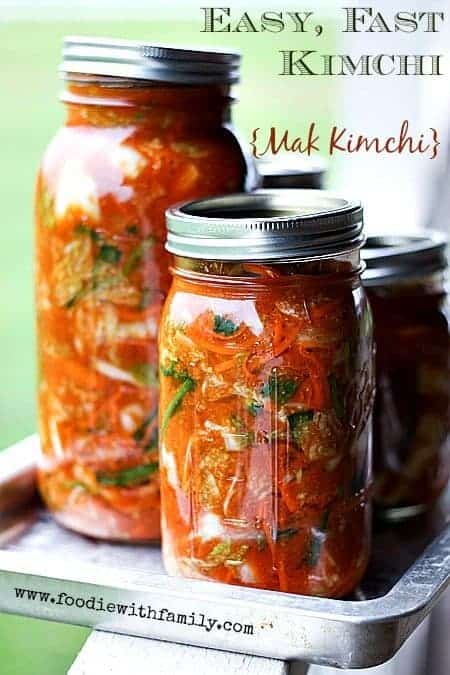
Love this Easy, Fast Mak Kimchi recipe? Check out our other fabulous Korean Food Recipes!
If you’ve been with me for a while, you’re well aware of my undying love for kimchi. Yes, it is stinky and bubbly and more than a little wild, but WOWZA the taste and the texture are so worth it.
If you’re new to the Foodie with Family family and you aren’t familiar with kimchi, I can give you a super condensed description; it’s essentially spicy, aromatic Korean sauerkraut. Today, I’m bringing you a fool-proof Easy Fast Kimchi recipe {Mak Kimchi}.
What is Kimchi?
Kimchi comes in almost as many forms as there are vegetables because nearly any vegetable can be fermented. They range from super mild smell to mega funky and mellow to melt-your-face-off spicy and there is one for every possible point in between.
The kimchi recipe that I’m sharing today is my family’s favourite version. It’s chock full of fabulous pro-biotics (as most kimchi is) and the longer it ages (translation: ferments) the stronger it becomes in both flavour AND pro-biotic content.
It’s like yogurt on steroids, people. That’s how good it is for you!
Is Kimchi Good For You?
Health Magazine named kimchi one of it’s Top 5 World’s Healthiest Foods. It is is low in calories and fat and high in dietary fiber and wicked high in Vitamins A, B, and C.
Many (if not most) Koreans eat a little kimchi with each meal or at least once a day. Kimchi is credited with helping most Koreans avoid obesity by virtue of its ability to satisfy even while being low calorie and low fat.
Seoul National University conducted a study and claimed that chickens infected with the H5N1 virus, also called avian flu, recovered after eating food containing the same cultured bacteria found in kimchi. That’s good enough for me!
How to Make Kimchi
Let’s get cracking and make some kimchi, shall we? The variety we’re making today is an Easy, Fast Kimchi recipe or Mak Kimchi…
In other words, it’s already cut up and ready to shovel into your mouth. Unlike what is usually just called ‘kimchi’ which is whole heads of napa cabbage smeared with the kimchi paste and allowed to ferment all wrapped up.
This version is FAR easier to make and far faster to be ready. Bonus, it is way easier to eat straight from the jar with a pair of chopsticks or a fork.
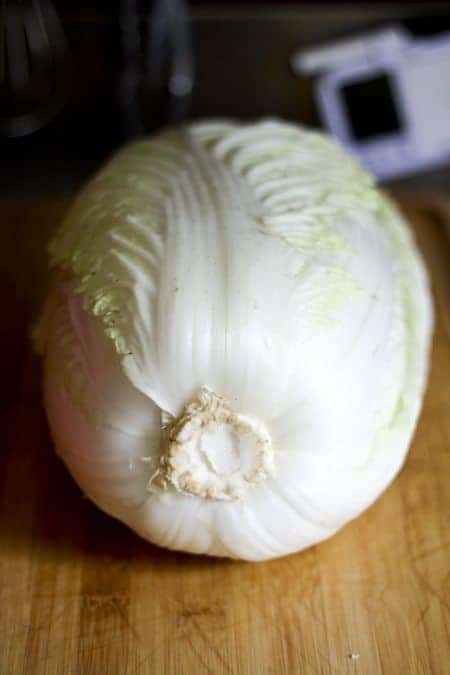
Do I need special tools to make kimchi?
In short, no. All you really need is a knife, a cutting board, and a big bowl. You will need a couple of ingredients that you may not have purchased before, but never fear, they’re not hard to find these days and I’ve included links to them below.
To begin with, you’ll need a big old head or two of Napa cabbage. I had two heads like the one above weighing in at about 3 pounds each.
It yielded, when all was said and done, about 3 quarts of kimchi, so that was perfect for me. You can cut that back if you think you can’t consume that amount of our Easy, Fast Kimchi recipe or Mak kimchi.
But I find all sorts of places to tuck it in, so it’s not an issue here and it’s only my husband, myself, and two of our boys who eat it. We love our kimchi.
Kimchi Recipe
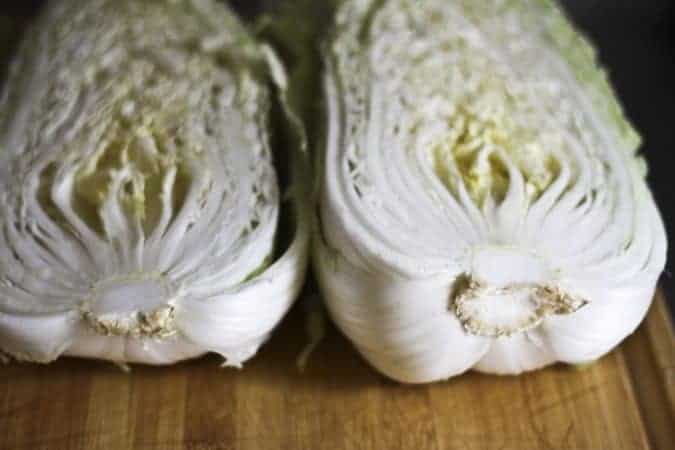
Lob your cabbages in half lengthwise. Use a paring knife to remove the gnarly core from them before cutting in half lengthwise again, leaving you with quarters.
Cut across the quarters to make bite-sized squares of cabbage. I usually shoot for 2-inch squares.
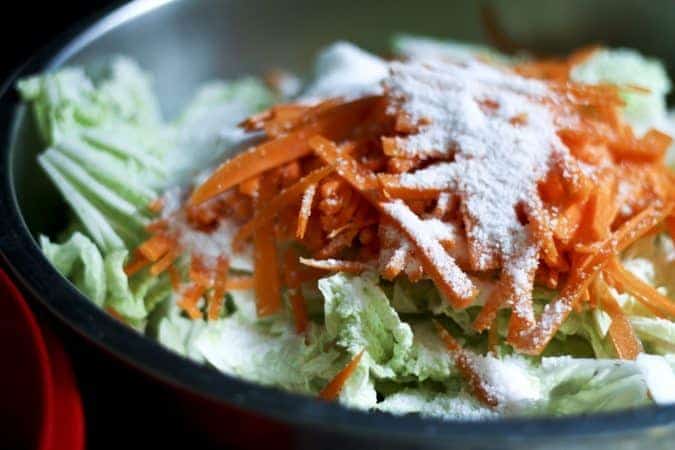
Add the cabbage to a monstrously huge bowl (or bowls), top with the julienned carrots, and sprinkle salt over the whole works. Toss the veggies and massage the mixture until the cabbage just starts to wilt.
Pour in enough cold water to over all the cabbage and carrots by a bit. It doesn’t have to be swimming in water, just covered.
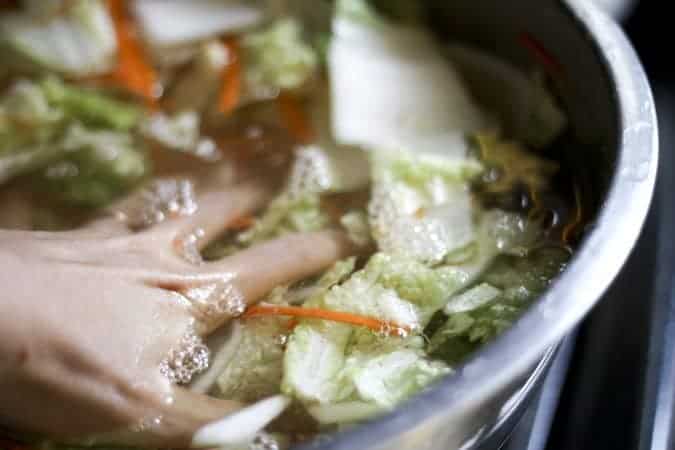
Stir it up with your hands and let it rest at room temp for a couple of hours.
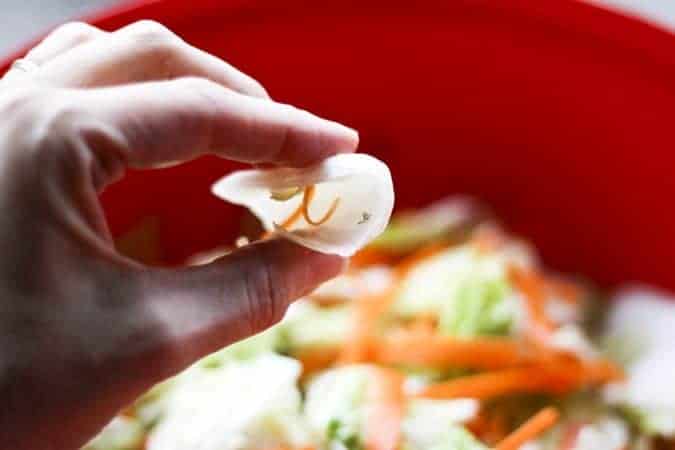
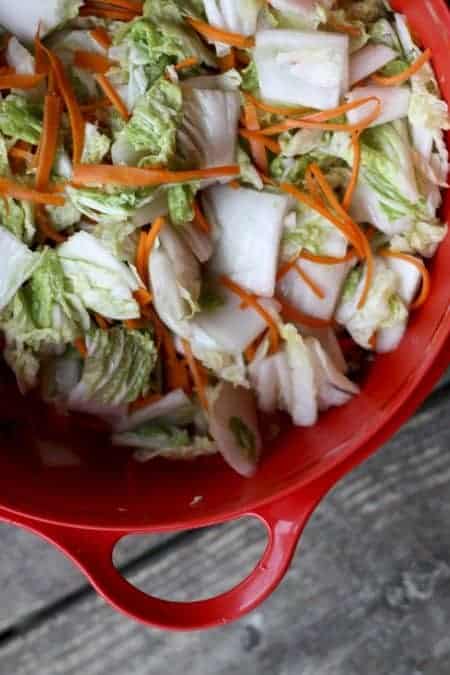
After a couple of hours, when the sturdier pieces of cabbage have become flexible, pour the whole lot into a strainer and let the brine water drain away.
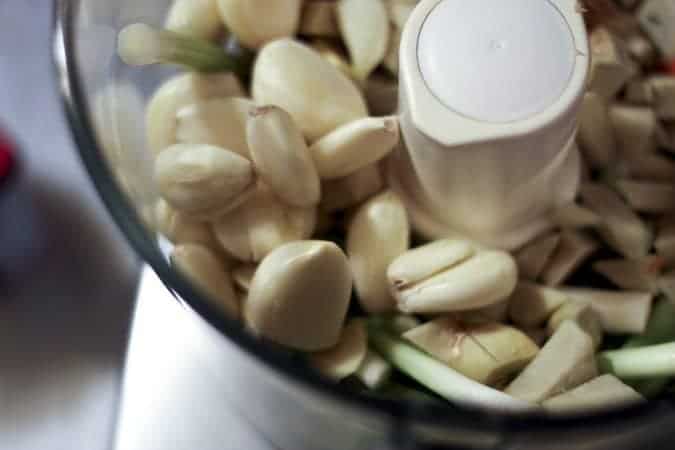
Now you’re going to whizz up the good stuff. Garlic, ginger, the white parts of scallions, Korean Red Pepper Powder*, fish sauce, unsweetened pear or apple juice, miso paste, and whatnot go into the food processor or blender.
Obliterate and smash it all into a lovely, red, fabulous smelling paste. It’s worth noting that you shouldn’t just up and increase the garlic because it can make kimchi linger more on your breath than you’d like it to do.
It also tastes out of balance if you add a lot more. Be aware.
And by the same token, you shouldn’t increase the ginger willy-nilly because that can make the final product a little more bitter than you’d like it to be. Start with the mixture and proportions I’m giving you and then play with it in subsequent batches.
*It’s important to note that you cannot use American or Mexican Chili Powder in place of the Korean pepper powder here. They’re COMPLETELY different animals. It may end up tasty, but I haven’t tested it so I cannot speak to it.
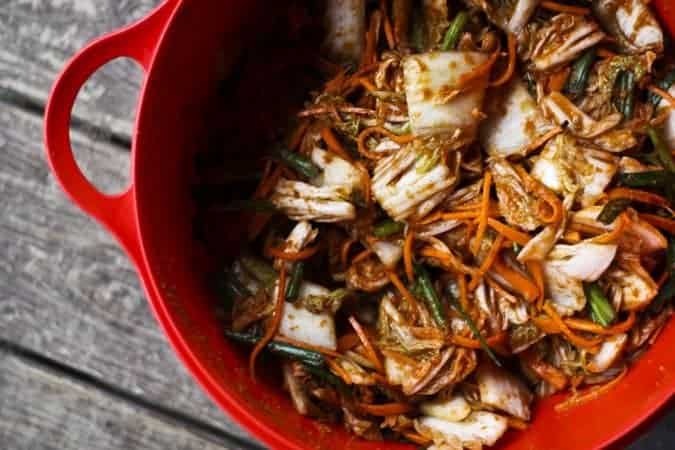
Now you’ll CRAM this stuff into jars or food-safe plastic containers. When I say cram it, I mean shove it in there as firmly as you can without putting your fist through the bottom of the jar.
I do prefer glass canning jars, if you’re wondering, because they don’t retain odors like plastic does, and, well, this stuff is odiferous! You can use a dedicated plastic kimchi bucket if you’d prefer, though.
Gently place a lid and ring on the jar, but don’t screw it tightly into place because BOOM. It’ll pop. This is active stuff, mes amies!
Place the jar on a rimmed pan or baking dish. The rim is pretty crucial here, because as the kimchi ferments at room temperature (and more slowly but still actively in the refrigerator) it will bubble up and may release a little juice over the edge of the jars.
In other words, you could have a kimchi river a-flowin’ on your counter top unless you take precautions. It’s easiest to use the pan and not worry about your Easy, Fast Kimchi recipe or Mak Kimchi bubbling over onto your counters.
It’s going to spend a couple of days at room temperature getting bubbly and fragrant. Every day, you’ll insert a clean chopstick or butter knife into the jar to help release air bubbles and top the jar off with extra brine if needed to keep everything submerged.
When it’s almost carbonated looking (usually between 24-72 hours after packing the jars), it’s ready to refrigerate. I highly recommend refrigerating it on the tray you used to contain the Grand Kimchi River while it fermented.
There aren’t a lot of things quite as unnecessary as removing everything from a fridge and mopping kimchi juices off of it. Take my word for it.
How long can I keep homemade kimchi?
It’s ready to eat at that point! Of course, it gets stronger and more kimchi-y the longer it sits. I love cooking with the older stuff and eating the newer stuff ‘raw’.
One of my all-time best-loved ways to eat older kimchi is in pancake form. Not like Aunt Jemima pancakes or flapjacks, but savoury, crispy-edged, kimchi-studded, pan-fried, snack cakes that convert even die-hard kimchi skeptics.
It’s the only way my eldest likes kimchi, but OH how he loves it this way. And the smell of kimchi pancakes while they cook is irresistible.
Bonus: This stuff lasts just about forever when you make sure the veggies are submerged in the brine. It’s hard to go wrong.
What can I make with my kimchi recipe? How do I use kimchi?
-Kimchi Fried Rice AND another version of Kimchi Fried Rice (the second one has a fried egg on top. SWOON!)
-Korean Army Stew- Budae Jjigae
-Kimchijeon (Savoury Kimchi Pancake)
Kimchi Ingredients
Kimchi
Cut the napa cabbage in half longways, then in half again longways. Cut the core out of the four quarters.
Cut the cabbage into squares (about 2-3 inches square), pop it in a bowl with the carrots. Sprinkle with the 1/2 cup kosher salt, massage so everything is coated in salt and starting to soften and wilt. Fill with cold, chlorine free water to cover it well and let it soak for at least 1 1/2 hours.
Pour the cabbage and carrots and liquid into a strainer. Let the brine drain away.
Lob off the white bits of the green onions and put them in a food processor with the garlic cloves, ginger, miso paste, and korean pepper powder. Zap it on high ’til it’s smooth-ish. Add in the fish sauce and a couple of slops of pear juice and zap it more until it’s about pancake batter consistency… maybe a bit thinner.
Put the brined cabbabe/carrots in a big, anti-reactive (glass, enamel, or stainless steel) bowl. Rough chop the green parts of the onions and add those to the cabbage/carrots. Pour the chili paste combo over the cabbage and wear gloves to massage it all over the cabbage/carrots green onions so everything is completely covered.
Pack super tight in canning jars. CRAM it in there.
Add a two-piece lid, but just set the ring in place to hold the lid down without screwing it in place. Place it on a rimmed baking dish to catch any spill-over.
Let it sit at room temperature for up to 72 hours, until it is bubbly and fragrant. Once every day, insert a clean chopstick or butter-knife to release air bubbles. If needed, pour in some additional brine to keep all the vegetables submerged.
Store on a rimmed sheet in the refrigerator for up to six months, being sure that the vegetables are submerged the whole time. The older it gets, the stronger it will become.
Notes
If you need extra brine to keep your vegetables submerged, please combine 1 quart of cool water with 4 teaspoons of kosher salt in a quart jar with a tight fitting lid and shake until the salt is dissolved. Use it to top off the vegetables as needed.
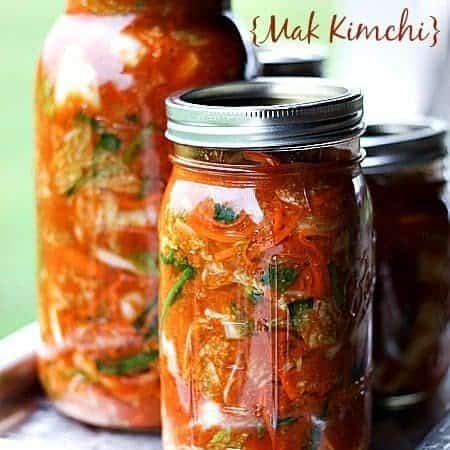
Easy, Fast Kimchi Recipe {Mak Kimchi}
Rate RecipeIngredients
- 3-8 pounds napa cabbage
- 2 bunches green onions trimmed of the root bits
- 2-3 large carrots peeled, thinly julienned
- 1/2 cup kosher salt
- 1/2 cup korean chili powder
- 15-20 cloves garlic overdoing garlic makes this stay on your breath more than usual., peeled
- 4-6 inches ginger peeled, rough chopped
- 1 tablespoon fish sauce
- unsweetened pear juice or unsweetened apple juice
- 4 tablespoons white miso paste
Instructions
- Cut the napa cabbage in half longways, then in half again longways. Cut the core out of the four quarters. Cut the cabbage into squares (about 2-3 inches square), pop it in a bowl with the carrots. Sprinkle with the 1/2 cup kosher salt, massage so everything is coated in salt and starting to soften and wilt. Fill with cold, chlorine free water to cover it well and let it soak for at least 1 1/2 hours.
- Pour the cabbage and carrots and liquid into a strainer. Let the brine drain away.
- Lob off the white bits of the green onions and put them in a food processor with the garlic cloves, ginger, miso paste, and korean pepper powder. Zap it on high ’til it’s smooth-ish. Add in the fish sauce and a couple of slops of pear juice and zap it more until it’s about pancake batter consistency… maybe a bit thinner.
- Put the brined cabbabe/carrots in a big, anti-reactive (glass, enamel, or stainless steel) bowl. Rough chop the green parts of the onions and add those to the cabbage/carrots. Pour the chili paste combo over the cabbage and wear gloves to massage it all over the cabbage/carrots green onions so everything is completely covered.
- Pack super tight in canning jars. CRAM it in there. Add a two-piece lid, but just set the ring in place to hold the lid down without screwing it in place. Place it on a rimmed baking dish to catch any spill-over. Let it sit at room temperature for up to 72 hours, until it is bubbly and fragrant. Once every day, insert a clean chopstick or butterknife to release air bubbles. If needed, pour in some additional brine to keep all the vegetables submerged.
- Store on a rimmed sheet in the refrigerator for up to six months, being sure that the vegetables are submerged the whole time. The older it gets, the stronger it will become.
Notes
Nutrition
Nutritional information is an estimate and provided to you as a courtesy. You should calculate the nutritional information with the actual ingredients used in your recipe using your preferred nutrition calculator.
did you make this recipe?
Make sure to tag @foodiewithfam on Instagram and #hashtag it #foodiewithfamily so I can check it out!
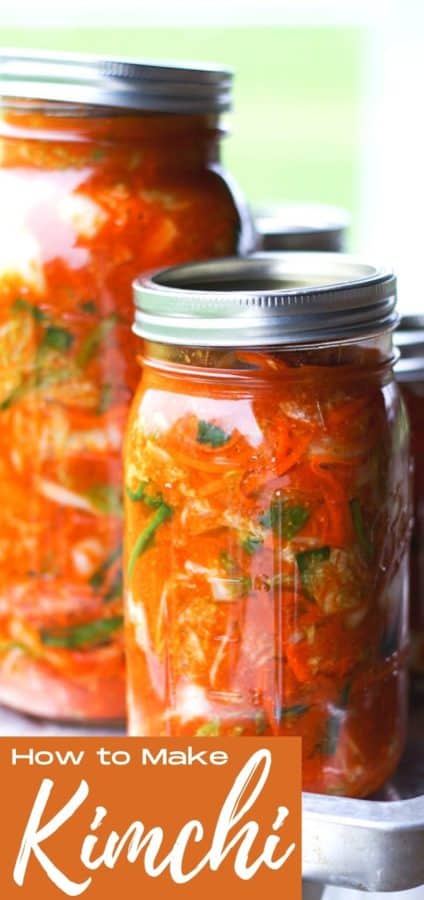
This post was originally published on December 2, 2013 and was updated December 28, 2016, June 2018, and September 2021.
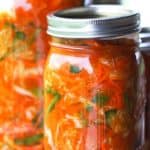



Reader's Thoughts...
DICK FLEMING says
SUPERFRAGILISTIC!
Richard says
can this recipe be canned & how to do it.
Rebecca says
Hi Richard- I’m afraid this is not suitable for canning. The good news is that it continues getting tastier and stronger as it ferments in cold storage.
Jay says
“Low in fat” ruined the credibility of this article for me.
Rebecca says
Interesting that a statement of fact would ruin the credibility of a recipe post for you. It is, in fact, low in fat at a whopping zero grams of any kind of fat whatsoever. For people who need to track that for medical reasons, that is helpful information to have.
Consuelo Ray says
Hello kimchi maker, I’m not sure if you
Check your mail, In any event hopefully you do I want to I’m planning to try at the kimchi recipe you have on the Internet and on and on and just wanted to thank you for writing for sharing this Connie from Bakersfield California, Also I am preparing this for my son he enjoys pickled food thanks again Rebecca
Bill Graham says
Question – Can I use regular cabbage?
Rebecca says
Hi Bill- I’m not sure how that would work. Kimchi is traditionally made with Napa cabbage, so I don’t know whether regular cabbage will behave the same way during fermentation.
Sheri Stewart says
After 72 hours I refrigerated my Kimchi (all in 102-Ounce jar with locking lid left ajar~not tightly fastened). Later I returned to the refrigerator to find the liquid level dropped down considerably. When it was on the counter it did overflow as per your instructions. I made a bit of brine with distilled water and kosher salt, added enough to cover vegetables and locked lid down tight. Is this okay?
Bryon says
I have a couple comments and a concern. Really liked the simplicity of your recipe from others I looked at. This is my first attempt at making Kimchi. Followed your recipe except for adding shrimp to the recipe. All went well got it packed in the big jar I wanted to store it in, and the juices from the mixture were enough to cover once I got done packing it in. It was an the counter for several hours before I went to bed and seemed to still have plenty of liquid on top. Next morning the top was dry. So I mixed up some more brine according to your 4tsp to quart of water. Added to cover by more than an inch. Now 14 hours later it is again dry on top and seems to be growing (by volume) in the jar. Just added more brine to cover. Cant really say I saw any bubbles on top, but I did notice some through the glass sides of the jar in the actual mixture. Do you think I have a problem? Is it actually fermenting ? Tried a taste as I did the second add of brine, the flavor is absolutely grand.
Bryon says
Oh No, the post just above me wasn’t visible to me until I came back to speak again. Tried the Kimchi again and it is way salty. Wish I had caught that post before I did the big add of brine. Big difference between 1 teaspoon, as compared to 1 table spoon. Note I did abbreviate my original post incorrectly. I added 4 tablespoons of salt not teaspoons.
J. Ivanski says
Hi,
I read through all the comments as I was curious about how to make the additional brine you mention. In some comments, you say to add 1 Tablespoon of salt per cup of water and in others it’s 1 teaspoon. Could you please clarify?
Thanks for the recipe. I just bought some kimchi yesterday and have decided to make my own which is how I stumbled on your website.
Rebecca says
Hi J- Thanks for catching that! It should be 1 tablespoon per cup of water.
Paula says
Can a fermentation weight be used to help keep the veggies under brine?
Can’t wait to try this!🤪
Rebecca says
It sure can, Paula!
Diana says
I may be confused but the list say 3 to 8 pounds of cabbage, while all the other ingredients stay the same?
Meaning I will add 20 cloves of garlic to 3 pounds or 8 pounds of cabbage?
Thank you I really want to try it.
Rebecca says
Hi Diana-
I understand the confusion, but yes, you keep those other ingredients the same. If you have the larger amount of cabbage, the resulting kimchi will be milder while if you use the smaller amount, it’ll be more concentrated. I hope you enjoy it!
Dee says
Where does the apple or pear juice come in?
Rebecca says
Hi Dee- You add the apple or pear juice when you’re processing the garlic and such in the food processor. You just add enough to loosen it.
Gwen says
Hi. I’m wondering if you could describe “the older it gets, the stronger it becomes”? This batch tasted good at the start (thanks for the yummy recipe!), smelled good fermenting but now has a chemical taste to it? I used a true fermenting crock and did the batch as a whole. It also may have been 4 days instead of 3, I cant remember now but am wondering how the flavor changes as it ages? The only other fermented veg I’ve done is sauerkraut and have always liked its flavor as it aged. Thank you
Rebecca says
Hi Gwen- It smells gamier and funkier if that helps. Maybe a little less pleasant and more strident to the nose? And pretty sharp in flavour. When it gets that way, I like to mellow it out by stir frying it lightly!
Kathy says
Just an FYI. When I click on the white miso link it takes me to pear juice.
Ashley Borgia says
Does kimchee need to be refrigerated after the 72 hours at room temperature?
Rebecca says
Hi Ashley, it does indeed!
Dr Peter says
Thanks for this, especially the print option which means I can print to pdf. I’m about to try sauerkraut and will definitely try this if that works but not sure where to get Korean chilli powder. Pretty sure our local Chinese supermarket doesn’t have it. Might have to try online.
Rebecca says
It’s definitely available online, Dr. Peter! I am pretty sure I linked to where it is available on Amazon within the post.
Sherman newberry says
How much apple juice do you use?
Rebecca says
Hi Sherman- I use about 1/4 cup, or whatever I need to to loosen the paste up to the consistency I described in the recipe. 🙂
Sarah says
Hello! Just wondering what brine we add. Salt and water? Just water?
Thank you!
Sarah
Rebecca says
Hi Sarah- whisk 4 teaspoons of kosher salt into 4 cups of cool water ’til salt is dissolved. That’s your brine. 🙂
Elizabeth says
Tastes amazing. But a friend corrected me, you can’t use tap water (I didn’t understand that non-chlorinated water means it had to be distilled). It’s been sitting on the counter for 24 hours so far..do I need to put it in the fridge and just eat it within 2 weeks or will it possibly still ferment?
Rebecca says
You should still be okay, Elizabeth!
Elizabeth says
True story, it did ferment! I should have done more research on my own but as long as it’s bubbling and doesn’t smell strange (besides that good kimchi funk) you’re good. Maybe we don’t have a ton of chlorine in our tap water but it’s been fine. This stuff is some of the best kimchi I’ve ever had. I’m shocked, honestly. Used a whole Chinese cabbage head from our garden for it and can’t wait to try other veggies!
Rebecca says
I’m so glad it turned out great for you, Elizabeth, and that you love it!
John says
Awesome recipe. It is my first time making kimchi. You can’t go wrong with this. Ohh it is soo freaking good.
Tom says
I’m on my third batch. Love it on greens, love it on beans. Love it plain, or on a train. I’m making a fourth batch today, in a 5 liter crock. I’m using a more Korean pepper than the recipe calls for, just to ramp up the heat a bit.
Thanks for this terrific recipe!